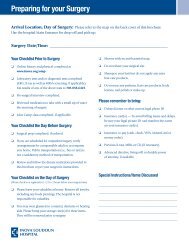what can we do to prevent childhood obesity? - Zero to Three
what can we do to prevent childhood obesity? - Zero to Three
what can we do to prevent childhood obesity? - Zero to Three
You also want an ePaper? Increase the reach of your titles
YUMPU automatically turns print PDFs into web optimized ePapers that Google loves.
plant life (e.g., vegetables): Plants <strong>can</strong> be poisonous.<br />
Instead of tasting any new item that they encounter,<br />
human children (in fact, nearly all mammals) determine<br />
<strong>what</strong> <strong>to</strong> eat by observing others around them.<br />
• Modeling eating behavior after peers may provide<br />
young children with some survival advantage. A<br />
biological perspective suggests that the nutritional<br />
needs of the young human are more similar <strong>to</strong> those of<br />
other young humans than <strong>to</strong> those of full-grown<br />
adults. For example, because children’s bodies are<br />
smaller than those of adults and <strong>to</strong> some extent less<br />
able <strong>to</strong> protect against infection, foods that adults <strong>can</strong><br />
eat or drink safely in reasonable quantities could prove<br />
<strong>to</strong>xic <strong>to</strong> a young child (e.g., sushi, steak tartar, unpasteurized<br />
apple cider, and alcohol).<br />
In brief, if nature had tried <strong>to</strong> equip children’s brains<br />
with a preset system for recognizing which foods are safe <strong>to</strong><br />
eat, a system that led children <strong>to</strong> imitate the behavior of<br />
the organisms most like themselves (i.e., other children),<br />
would clearly be the best design. This appears <strong>to</strong> be,<br />
indeed, the food-selection system that children use.<br />
Unfortunately, advertisers seem <strong>to</strong> have recognized the<br />
po<strong>we</strong>r of peers <strong>to</strong> influence children’s food preferences long<br />
before the rest of us. Anyone who has ever watched television<br />
recognizes that <strong>to</strong> sell food <strong>to</strong> children, advertisers use<br />
other children (e.g., “Mikey”) or characters designed <strong>to</strong><br />
appeal <strong>to</strong> and resonate with children. No cereal or <strong>can</strong>dy<br />
company would ever attempt <strong>to</strong> sell a product <strong>to</strong> a child<br />
with a commercial featuring a firm (yet kind and gentle)<br />
adult model eating the product while enthusiastically<br />
explaining <strong>to</strong> the child how “yummy” it is. Para<strong>do</strong>xically,<br />
this is exactly the method by which parents try <strong>to</strong> get children<br />
<strong>to</strong> eat healthy foods. Perhaps reframing our efforts at<br />
changing <strong>childhood</strong> eating behavior is in order.<br />
Food advertisements on television are po<strong>we</strong>rful. Children’s<br />
consumption of specific foods correlates with their<br />
having vie<strong>we</strong>d advertisements for these foods. Obese children<br />
are more likely than are children of normal <strong>we</strong>ight <strong>to</strong><br />
recognize food advertisements on television (Halford,<br />
Gillespie, Brown, Pontin, & Dovey, 2004). Even children<br />
as young as 2 years are more likely <strong>to</strong> select a food that<br />
they recently saw advertised in a 30-second commercial<br />
embedded in a car<strong>to</strong>on than are children who have<br />
watched the car<strong>to</strong>on without the commercial (Borzekowski<br />
& Robinson, 2001). Unless the government <strong>can</strong> be convinced<br />
<strong>to</strong> provide sufficient funding <strong>to</strong> advertise vegetables,<br />
whole grains, and milk on television with the same<br />
vigor and enormous advertising budget of the junk-food<br />
industry, hawking healthy food <strong>to</strong> children through television<br />
may be an unreachable goal. Ho<strong>we</strong>ver, children who<br />
attend preschool and child care are exposed <strong>to</strong> peers in eating<br />
situations every day. These interactions may be prime<br />
opportunities for promoting the transmission of healthy<br />
food preferences bet<strong>we</strong>en and among children.<br />
PHOTO:MARILYN NOLT<br />
What Is the Right Way <strong>to</strong> Parent <strong>to</strong><br />
Prevent Obesity?<br />
Parents <strong>do</strong> exert some control over how their children<br />
learn <strong>to</strong> prefer healthy foods and regulate food intake.<br />
Therefore, professionals who work with the parents of<br />
young children should base their recommendations about<br />
nutrition and feeding on solid scientific evidence. Unfortunately,<br />
although professionals frequently give families<br />
advice on these <strong>to</strong>pics, <strong>we</strong> have little data <strong>to</strong> back up our<br />
suggestions.<br />
For example, early <strong>childhood</strong> professionals and clinicians<br />
generally believe that young infants should be fed<br />
“on demand.” (Whether or not parents actually accept and<br />
implement this advice is an unans<strong>we</strong>red question.) But<br />
although feeding an infant on demand may certainly promote<br />
a sense of security and help the infant <strong>to</strong> calm and<br />
self-regulate, <strong>we</strong> have no evidence <strong>to</strong> suggest that feeding a<br />
baby on demand has anything <strong>to</strong> <strong>do</strong> with her eventual ability<br />
<strong>to</strong> regulate appetite. Interestingly, at some point in the<br />
early <strong>childhood</strong> years, ho<strong>we</strong>ver, general professional opinion<br />
and advice seem <strong>to</strong> shift from feeding “on demand” <strong>to</strong><br />
feeding at scheduled snack and mealtimes. We encourage<br />
parents <strong>to</strong> have a child wait until dinner for food, even if<br />
he or she is clearly hungry. The theory is that the child will<br />
then “have a good appetite” and will “eat a good dinner.”<br />
On the other hand, some professionals advise parents <strong>to</strong><br />
allow young children <strong>to</strong> “graze” on healthy foods all day<br />
long. They counsel parents <strong>to</strong> allow their child <strong>to</strong> eat a<br />
snack when they ask for one, with the thought that the<br />
child is learning <strong>to</strong> respond <strong>to</strong> his hunger cues accurately.<br />
ZERO TO THREE<br />
January 2005<br />
16

















